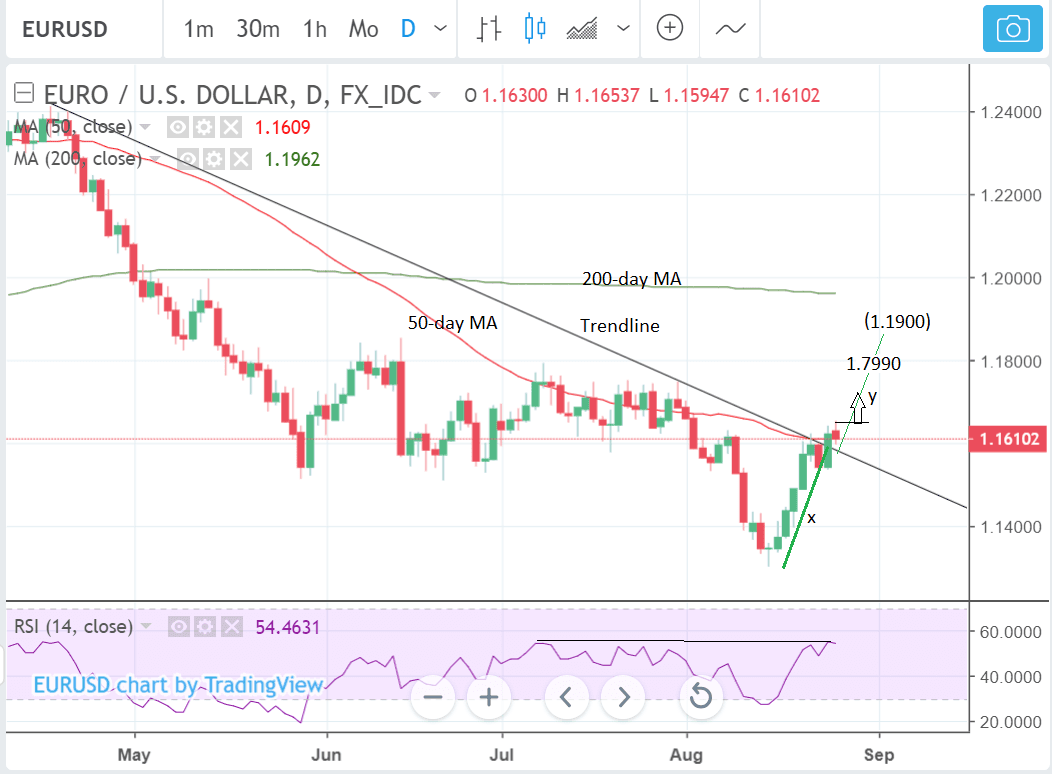Euro-Dollar Week Ahead: Break Above Trendline Strongly Suggests New Bull Trend

Image © OkFoto.it, Adobe Images
- EUR/USD breaks above trendline in notable move higher
- New uptrend probably established but 50-day moving average stands in the way
- The main release for the Euro is inflation data and for the Dollar personal consumption expenditure data
The Euro starts the new week on the back-foot against the US Dollar with EUR/USD trading lower at 1.1608, however earlier in the day the pair hit a new three-week best at 1.1646.
Technically, the near-term outlook for the Euro-to-Dollar exchange rate has improved with a break above the trend-line drawn from the April highs being a bullish sign for the pair, which suggests the potential for follow-through moves higher could be on the horizon.
The usual method for determining how far the exchange rate will go after a trendline break is to take the length of the move immediately prior to the break and extrapolate it higher from the break.
An extrapolation of the golden ratio, a mathematical constant equal to 0.618, produces the conservative 'minimum' target and an extrapolation of the whole length produces the upper target.
The minimum target in this case is 1.1790 and the maximum is just over 1.1900.
One major obstacle to further upside remains, the 50-day MA at 1.1609, which is at about the same level as the current spot price. The exchange rate needs to break clearly above the MA to continue rising, which will not be easy, however, we expect it to do so eventually, given bulls will be full of confidence after the trendline, and therefore more likely to push the pair higher.
A move above the 1.1654 highs would confirm a break above the MA to the next target at 1.1790, and although there may be some temporary resistance on the way in the 1.1680s, nevertheless, the pair is likely to reach its target eventually.
Momentum, as measured by RSI, is at the same level it was back in July when the exchange rate was in the 1.17s and this further supports the bullish case, at it is a sign of what is known as 'convergence', which is a bullish phenomenon.
Advertisement
Get up to 5% more foreign exchange for international payments by using a specialist provider to get closer to the real market rate and avoid the gaping spreads charged by your bank when providing currency. Learn more here
The Euro: What to Watch
The main release in the week ahead for the Euro is preliminary inflation data for August, out on Friday, August 31, at 10.00 B.S.T.
Inflation data is forecast to show a 2.1% rise in broad inflation and 1.1% in core inflation which leaves out volatile food and fuel components compared to a year ago.
Higher-than-expected inflation might boost the Euro if it is substantially higher than estimates as it would increase the probability of the European Central Bank (ECB) raising interest rates earlier than the currently-expected date of Autumn 2019.
However, all indications suggest inflation is unlikely to move materially higher and we therefore are sceptical that the single-currency will find support from this channel.
The Eurozone unemployment rate in July, is released at the same time, and is forecast to show a 8.2% rise from 8.3% previously. A stronger-than-expected unemployment print would also be expected to impact positively on the Euro as it reflects a healthier economy, which makes foreign investors more likely to invest in the region, increasing inflows and therefore demand for the currency.
The US Dollar: What to Watch
On the data front, meanwhile, a report on U.S. personal income and spending, which includes the personal consumption expenditure (PCE) metric - the Fed's preferred inflation gauge - will be one of the data releases which most captures the market's attention in the week ahead.
This is especially true after Federal Reserve Chairman Powell's more dovish comments at Jackson Hole - dovish meaning leaning to lower interest rates rather than higher. Powell said the inflation rate did not look likely to rise much beyond the Fed's 2.0% target, which suggested interest rates might not move substantially higher than the level currently expected by the market.
PCE for the month of July is forecast to show a 0.2% rise compared to the previous month when it is released on Thursday at 13.30 B.S.T.
Compared to a year ago, PCE is forecast to rise 2.0% compared to 1.9%.
Other related data released at the same time includes personal income and personal spending, forecast to rise by 0.3% and 0.4%, respectively.
Wednesday sees the release of the second estimate for US GDP in the second quarter and this may be one to watch because the preliminary estimate was so high at 4.1%.
The market will want to see confirmation this was not an exaggeration from the second estimate, currently forecast to come out at 4.0%.
Given how significant the US Consumer is in any analysis of the US economy or the Dollar, because most growth is generated by private consumption, the Conference Board Consumer Confidence data release in August, is likely to be a closely watched data release in the week ahead. The Conference Board's index is expected to drop to 126.5 from 127.4, when it is announced at 15.00 on Tuesday, August 28.
Another major release is Pending Home Sales in July, which is forecast to fall to 0.4% from 0.9% when it is released on Wednesday at 15.00 GMT.
Advertisement
Get up to 5% more foreign exchange for international payments by using a specialist provider to get closer to the real market rate and avoid the gaping spreads charged by your bank when providing currency. Learn more here





